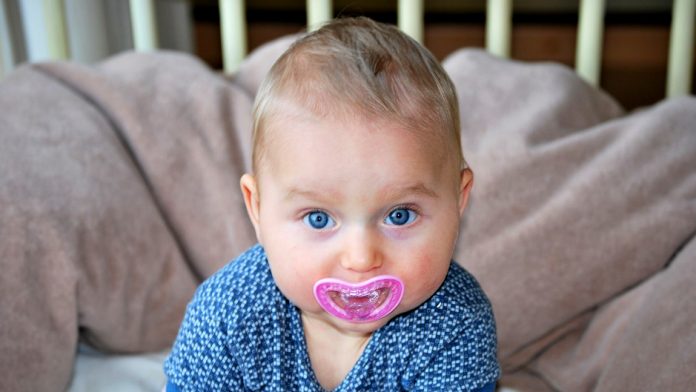From birth, babies are already primed to learn languages heard in the womb. Prof. Janet Werker is a professor in UBC’s Department of Psychology, CIFAR fellow, and 2015 SSHRC Gold Medal winner for her work on language acquisition. She looks for clever ways to assess language recognition and learning long before babies can communicate their understanding with words, revealing insights into this fascinating period of rapid development.
For instance, she uses light to detect changes in blood flow in the brains of sleeping newborns as they listen to recordings in various languages. Another approach is to use a pacifier with a pressure sensor to measure attentiveness, as babies will suck harder or faster when sounds interest them. Pitch, rhythm, and consonant and vowel sounds of native languages are all properties that babies can recognize and respond to.
How do researchers measure language skills in pre-verbal babies?
Video courtesy of KidCare Canada Society
Remarkably, even newborn babies are more attuned to speech patterns than other equally complex sounds, and are especially interested when listening to the languages they were frequently exposed to in the womb. The rhythms and tones that are specific these languages are transferred across the uterine wall, and these studies suggest that babies are listening and learning, even before birth.
Moreover, babies exposed to more than one language in utero respond to them equally well. Not only that, but they can also discriminate between two languages; when multi-lingual babies listen to sentences all in one language for long enough to lose interest, an abrupt switch to the other language re-engages their attention.
It is easy to boil down language acquisition as an activity primarily based on auditory input, but Prof. Werker’s studies also show that babies are active participants as they listen. Beyond practicing vocalization, babies also mimic tongue placement when listening to speech, and this movement influences how they hear. Consequently, babies whose tongue movement is restricted, such as with a teething toy, are unable to distinguish between similar sounds that the same babies can easily distinguish when their tongues are free to move.
Learning language goes beyond hearing; babies practice tongue movements before speaking
Video courtesy of UBC Public Affairs
These results can be applied broadly to assess language delays or language excellence in early childhood, and may even one day find applications in early interventions for disorders such as dyslexia. It may also help researchers treat babies with birth defects, such as cleft palate, which would interfere with the ability to mimic tongue placement. Also, knowing that movement is important to language development, this knowledge may change the design of medical equipment, such as ventilators, to accommodate free tongue movement.
Want to learn even more about language? Check out Orange Chair Interviews by Prof. Daniela O’Neill on early childhood language development or Prof. Wade Davis on the human legacy of culture and language.











































